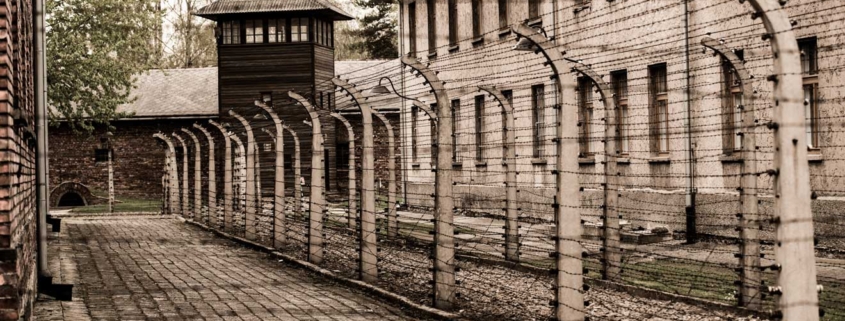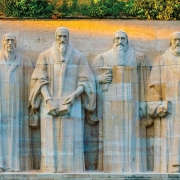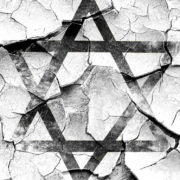Anti-Jewish Sentiment in Protestant Christianity (Pt. 3 of 4)
As we saw in the first two parts of this series, the anti-Jewish and anti-Semitic teachings of Protestantism began with the Reformers of the 1500s, and continued to grow and develop in the centuries that followed. Then, during the twentieth century, the anti-Semitism of previous generations came to a head, showing itself fully at the zenith of Jewish persecution: the Holocaust.
As the Nazis came to power, many German Protestants spoke out in support of the Holocaust, directly referencing writings of Martin Luther from 400 years before.1 They affirmed his call for Christians to deal with “this rejected and condemned people, the Jews” by “set[ting] fire to their synagogues or schools… in honor of our Lord and of Christendom,” and by causing Jewish “houses also be razed and destroyed.”2 Soon, the Protestant Church in Nazi Germany split into two groups: the “German Christians” (who supported the Nazis) and the “Confessing Church” (who opposed the Reich).3
Not surprisingly, the “German Christians” were extremely anti-Semitic. Two weeks after Kristallnacht—a night of widespread destruction of Jewish property and massive imprisonment of Jews—German Christian bishop Martin Sasse reprinted excerpts of Luther’s works to support Jewish persecution,4 calling his readers to remember and emulate “the Anti-Semitism entertained by the Church during its times of potential splendour.”5 Another Nazi theologian, Gerhard Kittel (1888–1948), echoed the thoughts of John Wesley by saying that Jews should simply accept that they are cursed to be “restless and homeless” foreigners who are discriminated against.6
Even in the “Confessing Church,” anti-Semitism and anti-Jewish theology remained prevalent. According to author Christopher Probst, “a characteristically conservative Confessing Church approach… affirmed the authority of the Old Testament while demeaning the present-day Jew, defining him by the curse brought on by his rejection of Jesus as the Messiah.”7 Confessing Church pastors charged Jews with a “unanimous rejection” of Jesus (ignoring the tens of thousands of Jews who followed Yeshua, as seen in Acts 21:20), called Jews the very representation of opposition to the Church (reflecting Luther’s words), and told Christians to love Jews but also to combat them as adversaries because they are a rejected people.8
Despite the horrors of the Holocaust, these same sentiments continued to exist within the Protestant church following the war. Even American evangelist Billy Graham (1918–2018), who greatly improved relations between Jews and Protestants,9 held to anti-Jewish theologies and anti-Semitic stereotypes for a time. In a conversation with Graham in 1972, President Richard Nixon expressed vexation because the American media was supposedly “dominated” by Jews. Shockingly, Graham agreed with Nixon,10 saying this domination can be explained by Scripture. “You see, the Bible makes a distinction, Mr. President, between two groups of Jews. One is called the Synagogue of Satan…. In other words, they are energized by a supernatural power called the Devil…. [O]f course Hitler didn’t [do it right]—[the Jews] had a stranglehold on Germany.… But [Hitler] went about it wrong. But this stranglehold has got to be broken, or this country is gonna go down the drain.”11 Graham’s idea of Jews who have a stranglehold on society and are energized by Satan is parallel to Luther’s libel that “the devil and all his angels” inhabit Jews12 and “they hold us and our property captive.”13 Though Graham apologized and renounced his words when tapes of the conversation were released in 2002,14 the fact that he had ever held such beliefs should be quite rattling.
The twentieth century writings of well-known preacher John MacArthur (1939–) also show an inability to fully break from ingrained anti-Jewish theology. Despite expressing very philo-Semitic ideas and teaching that God has not rejected Israel, he said that in the “present dispensation,” God has intentionally “set[] aside” the Jewish people in His plan.15 This dispensationalism is a lite form of replacement theology, claiming that, though God has not permanently replaced the Jewish people, He has done so temporarily during the Christian period of history. Like Graham, MacArthur taught that the reference to the “Synagogue of Satan” in Revelation 2:9 is speaking of unbelieving Jews,16 though the Bible clearly describes this group as “those saying themselves to be Y’hudiym [Jews], and are not” (mjlt). Such rejection of the plain meaning of this description—namely, that it is speaking of Gentiles who falsely claim Jewish lineage—has been utilized by anti-Semites for centuries, and (as David Stern points out) testifies to the “anti-Jewish mindset” of Christianity.17
Did this post bless you?
♥
The 1900s show us that the ideas surrounding replacement theology are not simply harmless doctrinal errors. If left unchecked, these anti-Jewish concepts can grow into the most vile anti-Semitism, even leading to participation in atrocities against the Jewish people. Yet despite the great evils these sentiments have helped to bring about, the theologies remain unaddressed and—as we will see in the final part of this series—continue to pervade Protestantism to this day.
What do you think? Share your thoughts in the comments below!
- Probst, Christopher J. Demonizing the Jews: Luther and the Protestant Church in Nazi Germany. Indiana University Press, 2012: introduction ↩︎
- Luther, Martin. “On the Jews and their Lies.” Luther’s Works. Editor Franklin Sherman, Translator Martin H. Bertram. American ed. Vol. 47. The Christian in Society IV. Concordia Publishing House and Fortress Press, 1971. pp. 121–306, 268–269 ↩︎
- United States Holocaust Memorial Museum, Washington DC. “The German Churches and the Nazi State.” Holocaust Encyclopedia. (Accessed 17 Jul. 2023) ↩︎
- Probst, chapter 1 ↩︎
- Sasse, Martin. Martin Luther and the Jews. Hollywood, CA, Sons of Liberty, 1967: 3.
Archive.org, Martin Luther and the Jews (Accessed 2 Feb. 2021)
↩︎ - Brown, Michael L. Our Hands Are Stained with Blood: The Tragic Story of the Church and the Jewish People. 2019 ed., Destiny Image Publishers, 2019: 33 ↩︎
- Probst, chapter 3 ↩︎
- Ibid., chapter 4 ↩︎
- Neff, David. “Graham and the Jews: A Complex Connection.” Christianity Today, February 21, 2018.
Archive.org, Christianity Today (Accessed 13 Jul. 2023) ↩︎ - Richard Nixon Presidential Library and Museum. White House Tapes. OVAL 662-004. Yorba Linda, California, 1 Feb. 1972: 26:23–29:11 (Accessed 13 Jul, 2023) ↩︎
- Ibid., 29:12–30:53 ↩︎
- Luther, 174 ↩︎
- Ibid., 266 ↩︎
- Firestone, David. “Billy Graham Responds to Lingering Anger Over 1972 Remarks on Jews.” The New York Times 17 Mar. 2002: pp. 29. ↩︎
- MacArthur, John. “Has God Cancelled His Promises to Israel? Part 1.” Grace To You, 3 Jun. 1984.
Grace To You Sermons Library (Accessed 13 Jul. 2023) ↩︎ - MacArthur, John. “Smyrna: The Suffering Church.” Grace To You, 12 Jan. 1992.
Grace To You Sermons Library (Accessed 13 Jul. 2023) ↩︎ - Stern, David. Jewish New Testament Commentary. 6th Ed. Jewish New Testament Publications, 1999: 795 ↩︎










I am shocked and so sad. Wondered why my church isn’t praying regularly and together for Israel and the Jewish people especially at this time !